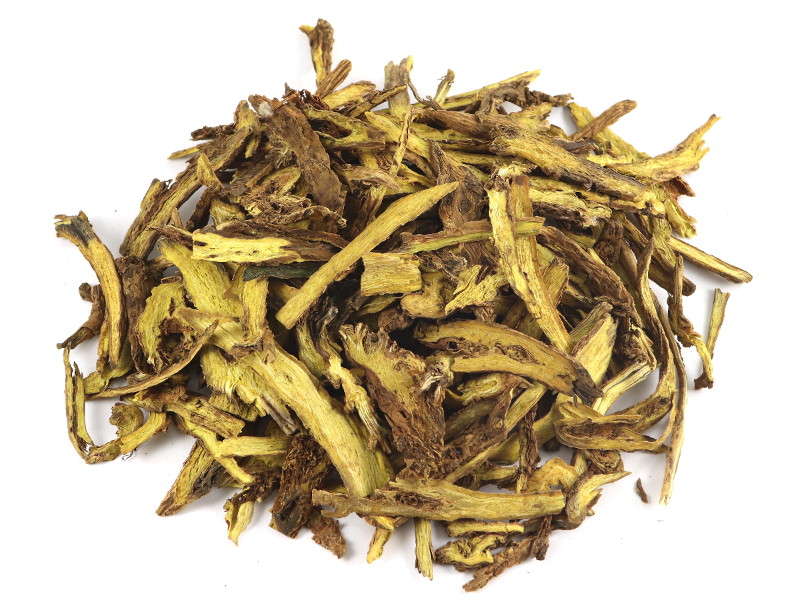
Ah, scutellaria root! I have a certain fondness for this plant since we have spent so many hours together over the years. During the making of our tinctures, I have spent countless hours sifting through pound after pound of scutellaria root, selecting the healthiest, most yellow roots possible. I know its colour and texture well, and wouldn’t be surprised if I could recognize its distinctive, pungent odour in my sleep!
In Chinese herbalism, scutellaria root is known as one of the 3 ‘Big Yellows’ – herbs reknowned for their ability to clear internal heat in the body. Here, the word ‘big’ refers both to its importance in the TCM pharmacopia, and to its incredible ability to clear ‘big’, excessive heat, while the word ‘yellow’ is used because the root has a distinctive, yellowish tinge to it.
The other 2 ‘yellows’ are coptis rhizome, and rhubarb root, in case you’re wondering. These other two herbs are also heavily featured in our collection of tinctures, but here I will be talking only about scutellaria root. (A quick bit of trivia: in truth, there are actually 5 ‘Yellows’ in Chinese herbalism- herbs with the word ‘yellow’ right in the middle of their Chinese names – but only the ‘Big Three’ clear intense, excess heat).
The word ‘yellow’ is an important association to make with scutellaria root as it helps with identification. In fact, the distinctive yellowish tinge of scutellaria root has long been such a selling point that many Chinese herb growers used to add sulphur to the root to make the colour really stand out. It made the roots appear more potent. It’s been many years since this practice has been banned, but the basic fact still holds true: if you are looking for a really healthy scutellaria root, it should have some yellow in it. Brown, bedraggled-looking roots are of poor quality.
So, why is scutellaria root so great? Well, as I’ve already mentioned, it excels at clearing intense heat, particularly in the upper body. Accordingly, it has been shown to be effective in treating any upper body condition where bleeding is involved, be it blood-streaked sputum, frequent nosebleeds, or in stomach conditions where there is blood in the vomit [1]. In TCM, bleeding is a sign of heat so intense that the inflammation causes blood vessels to break open. This same, potent heat-clearing ability is why scutellaria is also a good herb of choice for lowering fever [2].
Since high blood pressure is another common sign of heat in the body, it’s not surprising that scutellaria root has been shown to reduce hypertension too. It appears to do this by dilating blood vessels so that pressure is reduced, but it also has the effect of “cooling” the sympathetic nervous system, so that the effects of stress on the body are reduced [3]. This means that scutellaria root may also be helpful for those who are chronically stressed.
Although it is most often used in Chinese medicine to treat upper body conditions, scutellaria also has a powerful effect on the liver, which is a little lower down in the body. Here, it has been shown to stimulate both the production and excretion of bile, thereby preventing the formation of gallstones. It also protects the entire biliary system from inflammation [4], and it has been successfully used to treat both infectious and chronic hepatitis [5].
To top it all off, scutellaria has powerful anti-bacterial effects similar to antibiotics such as ampicillin, amoxicillin, methicillin and cefotaxime. In fact, if scutellaria is used in conjunction with these antibiotics, their effectiveness against antibiotic-resistant bacteria such as beta-lactam-resistant staphylococcus aureus, and methicillin-resistant staphylococcus aureus (MRSA) is suddenly restored [6][7]. Wow!
If you’re interested in seeing the powerful effects of scutellaria root for yourself, you can find it in both our Chinese Bitters tincture and our Curcuma tincture. These two products are known for their ability to soothe liver issues, improve digestion, and increase blood circulation through the liver area, among other effects.
- Chem Pharm Bull, 1984; 32(7):2724
- Zhong Hua Yi Xue Za Zhi (Chinese Journal of Medicine), 1956; 42(10):964
- Zhong Yao Xue (Chinese Herbology), 1988; 137:140
- Ri Ben Yao Wu Xue Za Zhi (Japan Journal of Pharmacology), 1957; 53(6):215
- Zhong Hua Nei Ke Za Zhi (Chinese Journal of Internal Medicine), 1978; 2:127
- Zhong Yao Xue (Chinese Herbology), 1988; 137:140
- J Pharm Pharmacol 2000 Mar;52(3):361-6
About the Author: Rebecca Wong has a BA in English Literature from the University of Waterloo and has been working in the herbal business since 2000. She studied at the Ontario College of Traditional Chinese Medicine under respected authorities Paul Des Rosiers and Vu Le, and graduated from the East West School of Planetary Herbology under Michael Tierra. She received training as a yoga teacher at The Branches in Kitchener/Waterloo, and therapeutic yoga teacher training from the School for Somatic Soulwork under Deniz Aydoslu. She now teaches yoga for anxiety, depression and burnout at Rebecca's Restful Yoga Studio in Toronto.